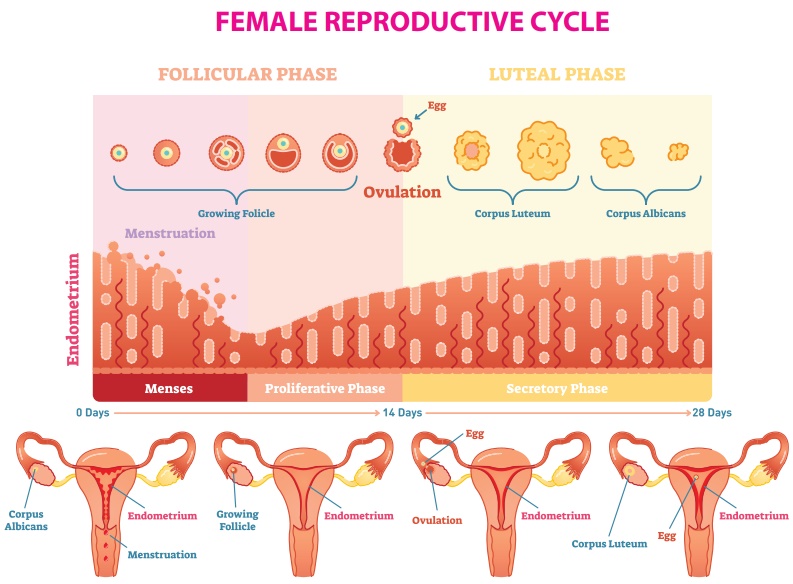Chapter: 12th Nursing : Chapter 5 : Maternal Health Nursing
Menstrual Cycle
MENSTRUAL CYCLE
Definition: Menstruation is a
visible manifestation of cyclic, physiologic uterine bleeding due to
shedding of the endometrial wall following invisible interplay of hormones
mainly through Hypothalamus-Pituitary-Ovarian axis.
Normal limits:
Frequency: 24-38 days
Regularity: +/- 2-20
days
Duration: 4-8 days
Volume: 5-80 ml
Physiology of Menstruation: The menstrual cycle is the scientific term for the physiological changes that occur in fertile women for the purpose of sexual reproduction. The menstrual cycle is controlled by the endocrine system.
The hormones involved in the menstrual cycle
The mechanism is
controlled by the hypothalamus.
·
Gonodotrophin releasing hormone.
·
FSH-Folicular Stimulating Hormone.
·
LH - Luteinizing Hormone.
·
Progesterone and
·
Estrogen.
Menstrual cycle can be explained in two cycles which occur concurrently
1. The ovarian cycle and
2. The uterine cycle
·
The
Ovarian Cycle consists of
o
The
follicular phase , ovulation and
o
The
luteal phase
·
The
Uterine Cycle consists of
o
menstrual
phase
o
The
proliferative phase and
o
The
secretory phase
1. Ovarian cycle
Follicular phase: The hypothalamus
released gonadotrophin releasing hormone, which stimulate anterior
pituitary gland and secrets follicle stimulating hormone (FSH). All the
follicles degenerated except one to mature into a large graffian follicle. The
follicle ruptures and releases an ovum into the peritoneal cavity.
The luteal phase:
Begins with ovulation. The body temperature drops of then rises by 0.5 to 1
around the time of ovulation. Corpus luteum is formed from follicle cells that
remain in the ovary following ovulation. Corpus luteum secretes oestrogen and
progesterone during the remaining 14 days of cycle. Corpus luteum degenerates,
if the ovum is not fertilized.
2. Uterine or Menstrual cycle
Menstrual phase: Characterized by vaginal
bleeding and lasts for 4-6 days. Physiologically this is the terminal phase
of the menstrual cycle. The endometrium sheds up to the basal layer along with
the blood from capillaries and the unfertilized ovum. Bleeding occurs when the
coiled arteries return to a state of construction.
Proliferative phase: This phase follows menstruation
and lasts until ovulation. The first few days the endometrium is reforming and
it is termed as “Regenerative phase.”. Estrogen stimulates proliferation and
growth of endometrium. Under the control of oestrogen re-growth and thickening
of endometrium begins. Ovulation occurs between day 12 and day 16.
Secretary phase: Lasts about 12 days.
This phase is initiated response to increase in luteinizing hormone.
Progesterone prepares the endometrium for pregnancy. The functional layer
thickens to 3.5 mm and become spongy in appearance. The endometrium is vascular
and rich in glycogen, spiral or coiled arteries develop. On day 27 and 28
oestrogen and progesterone levels fall because the corpus luteum is no longer
producing them. Without these hormones,he uterine lining becomes ischemic. The
lining starts to slough, the women has come to full cycle and it is once again
at day first of the menstrual cycle.![]()
Abnormalities in Menstruation
Premenstrual Syndrome (PMS).
PMS is any unpleasant or
uncomfortable symptom during menstrual cycle that may temporarily disturb normal
functioning. These symptoms may last from a few hours to many days.
Premenstrual Dysphoric Disorder (PMDD) is a much more severe form of PMS which
affects approximately 3%-8% of women of reproductive age. PMDD requires
treatment by a physician.

Amenorrhea: It is absence of menstruation.
Primary amenorrhea: Menstruation does
not begin at puberty.
Secondary amenorrhea: Normal and regular menstrual
periods which become increasingly abnormal and irregular or absent.
Dysmenorrhea: It is characterized by
severe and frequent menstrual
cramps and pain associated with menstruation.
Primary Dysmenorrhea: Women experience abnormal uterine contractions
resulting from a chemical imbalance in the body. Mostly in adolescents
Secondary Dysmenorrhea: Is caused by other medical
conditions, most often endometriosis.
Menorrhagia: It is the medical term
for excessive menstrual
bleeding. In a normal menstrual cycle, women on average lose about 30 ml of
blood for about 7 days of menstruation. If bleeding exceeds 7 days or too heavy
(over 80 ml), then it is called as menorrhagia. The main cause of menorrhagia
is an imbalance of estrogen and progesterone in the body.
Abnormal Bleeding: Abnormal vaginal bleeding (excluding
menses)
- Bleeding between
menstrual periods
- Bleeding after
sex
- Bleeding after
menopause
Metrorrhagia: Refers to menstrual
bleeding that is normal in amount
but occurs of irregular intervals, between the menstrual periods hemorrhage
from the uterus, independent of menstruation.
Menopause: It is the process
through which a woman ceases to
be fertile.
Related Topics